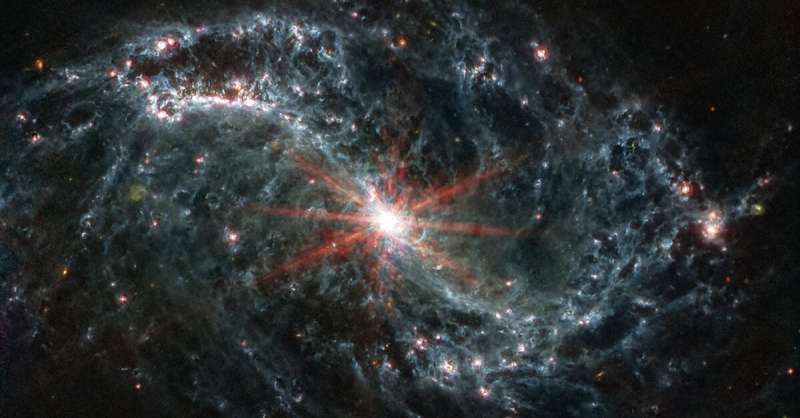
NGC 7496 lies over 24 million light-years away from Earth in the constellation Grus, and is one of 19 galaxies targeted for study by PHANGS. Its spiral arms are filled with cavernous bubbles and shells overlapping one another in this image from JWST’s Mid-Infrared Instrument (MIRI). These filaments and hollow cavities are evidence of young stars releasing energy and, in some cases, blowing out the gas and dust of the interstellar medium surrounding them. At the center of NGC 7496 is an active galactic nucleus — another way to refer to an active supermassive black hole. Credit: NASA, ESA, CSA, Joseph DePasquale/STScI
It is a popular notion that aside from large celestial objects like planets, stars and asteroids, outer space is empty. In fact, galaxies are filled with something called the interstellar medium (ISM)—that is, the gas and dust that permeate the space in between those large objects. Importantly, under the right conditions, it is from the ISM that new stars are formed.
Now researchers from the University of California San Diego, in collaboration with a worldwide project team, have released their findings in a special issue of The Astrophysical Journal Letters dedicated to their work using advanced telescope images through the JWST Cycle 1 Treasury Program.
“With JWST, you can make incredible maps of nearby galaxies at very high resolution that provide amazingly detailed images of the interstellar medium,” stated Associate Professor of Physics Karin Sandstrom who is a co-principal investigator on the project.
Although JWST can look at very distant galaxies, the ones Sandstrom’s group studied are relatively close at about 30 million light years away, including one known as the Phantom Galaxy. Also known as M74 or NGC 628, astronomers have known of the Phantom Galaxy’s existence since at least the 18th century.
Sandstrom, along with postdoctoral scholar Jessica Sutter and former postdoctoral scholar Jeremy Chastenet (now at University of Ghent), focused on a specific component of the ISM called polycyclic aromatic hydrocarbons (PAHs). PAHs are small particles of dust—the size of a molecule—and it’s their small size that makes them so valuable to researchers.
When PAHs absorb a photon from a star, they vibrate and produce emission features that can be detected in the mid-infrared electromagnetic spectrum—something that typically doesn’t happen with larger dust grains from the ISM. The vibrational features of PAHs allow researchers to observe many important characteristics including size, ionization and structure.
2023-03-05 19:00:04
Source from phys.org
Insight into Star Formation: Nearby Galaxies’ Images Illuminate the Process
The process of star formation has been studied for decades, but much remains unknown about the intricate mechanisms that lead to the birth of new stars. However, recent advances in astronomical imaging have allowed scientists to gain unprecedented insights into this fundamental process through observations of nearby galaxies.
One such technique is the use of multi-wavelength imaging, which combines data from different types of light, such as infrared and radio, to create a more detailed picture of star-forming regions. By examining the properties of these regions, such as the density and temperature of gas clouds, scientists can begin to unravel the complex processes that drive star formation.
Another approach is the use of high-resolution imaging, which can capture the fine details of star-forming regions, including the shapes and sizes of individual protostars. This technique has revealed that star formation is a highly dynamic process, with protostars interacting with each other and their surrounding environment in complex ways.
One of the most exciting discoveries in recent years has been the detection of “starburst” galaxies, which are undergoing an intense burst of star formation. These galaxies are often characterized by bright emission from ionized gas and massive young stars, and they offer a unique opportunity to study the extreme conditions under which stars form.
Through observations of nearby galaxies, astronomers have also been able to develop a more comprehensive picture of the life cycle of stars. For example, they have found evidence that star clusters can spawn multiple generations of stars, as the gas and dust ejected by dying stars provides the raw material for new ones.
Perhaps most significantly, these observations have helped to shed light on the role of feedback in the star formation process. Feedback refers to the energy and material that stars and star-forming regions release into their surroundings, which can in turn influence the formation of new stars. By studying feedback mechanisms, scientists hope to gain a better understanding of how stars form and evolve over time.
Overall, the use of advanced imaging techniques has provided a wealth of new information about the complex process of star formation. While much remains to be discovered, these observations have brought us closer than ever to unraveling the mysteries of our universe’s most fundamental process.
